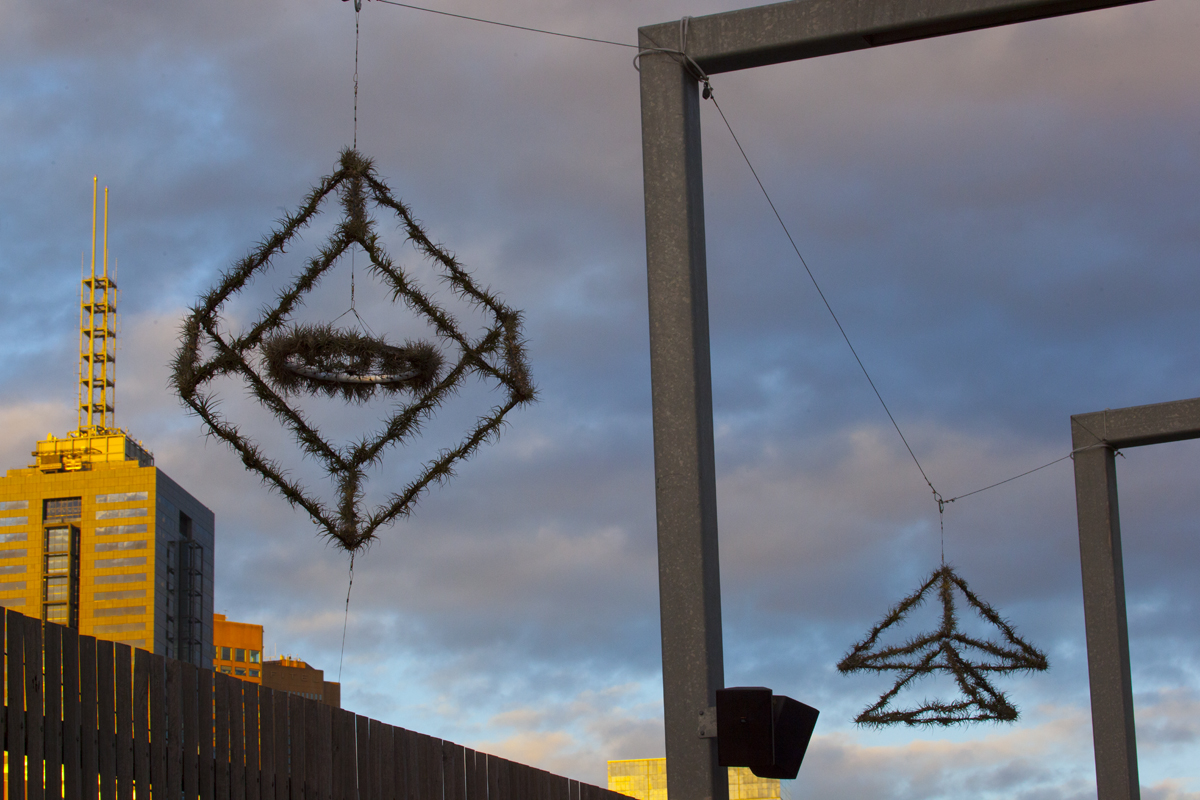
Airborne project - first installation of rotating air gardens at Les Erdi Plaza, Northbank, 9 Feb 29 2013, against the Fliders St Station clock tower
Supported by the City of Melbourne, through the Arts Grants Program
|

With the suspended air plant work I am interested in exploring how plants can occupy space but not surface. Suspension on and via wires extends the potential habitat of plants into what I term Alpha Space. While vertical and roof top gardens have become popular in major cities worldwide, they occupy surface, but these intriguing ground breaking air gardens step beyond earthly confines to rotate suspended in air or Alpha space.
My air gardens break new ground offering fresh dimensions by incorporating plants in our cities via innovation. They write a fight manual for plants to escape their earthly confines and occupy new space within our cities.
Unlike current vertical wall or roof top gardens applications, the approach is not to adapt the built environment to suit the plants but use plants that have evolved a specific biology to withstand the rigours of the urban environments we have created - pioneer plants like Tillandsia. To understand the significance of the air garden work it helps to have an overview of vertical gardens. Currently vertical gardens have seduced audiences with vibrant images of green walls, however long term too often they have proved expensive and difficult to maintain.
These vegetal walls:
- weight 30 - 60Kg a Sq m - there is considerable weight in the structure needed to support the plants and the water reticulated - as the plants grow they also add weight.
- require constant 24 x 7 support withg water and nutrient reticulation - pumps can break down, pipping become blocked with whole gardens dying within days, drains block and overflow
- often require a 20-30% replant a year - although whole gardens may not die sections within the total area can easily fail added to this is the fact every leaf eventually dies and to maintain the visual appearance at some point has to be removed
- cost 20% to 30% of the installation cost to maintain - with all vertical gardens a considerable financial cost is required to maintain the garden it is this cost that often sees cost cutting which leads to the eventual decommissioning of the garden
- cannot extend beyond vertical - these gardens cannot support plants with roots that extend past vertical
- require a opaque water impervious layer, a water impermeable layer is needed to keep the water intended for the garden away from the wall of the building, this layer is also opaque allowing no light to filter though
- increase the risk of physical damage to a building's façade or even structure - keeping water out of buildings has been a preoccupation of architects for thousands of year. Water reticulation risks water inundation while the plants roots have the potential to escape the defined wall and attack the surface and structure of the building.
- are fixed in place - weight and other constants like pumps etc. mean vertical gardens are not designed to be animated or easily moved
- the gardens can be vulnerable
to Windthrow − the wind’s effect in damaging or uprooting trees or plants
By contrast the rotating air gardens:
- weigh 2-3kg per sqm - with little infrastructure there is little weight to these living air sculptures
- are unsuported - they require no water and nutrient system at all - there simply is nothing to go wrong
- As the plants used in these air gardens grow slowly and can withstand hot dry conditions there is NO replant required
- Tillandsia grow Asexually, which means they can easily be harvested to create a new reserve of plants for a further planting - depending upon the species this can occur every 2-3 years - so 100% of the financial investment in plants is retuned every few years making these air gardens truly a super-sustainable investment, rather than cost money to maintain they produce an income.
- can not only suspend beyond vertical but be suspended in space and be designed to rotate in space on the slightest wind.
- do not need an opaque layer - they can be set against a buildings glass frontage to create a semi transparent plant screen allowing intermittent light penetration - they need not sit hard on the surface but can be suspended meters away from the surface.
- pose NO risk of watering systems to the surface and structure of a building
- can also be utilized to be moved as plant screens from a building's facade across a window as a light and heat screen.
|